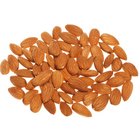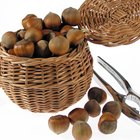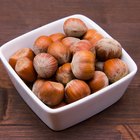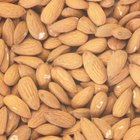
Ground almonds have a variety of uses in cooking. People who have celiac disease, gluten intolerance, or who follow a vegan diet can substitute almond meal for flour in recipes. Those who avoid leavened baked goods during the Jewish holiday of Passover might choose to grind almonds for baking purposes. You can also use these ground nuts to make marzipan. Grinding almonds at home takes a little more time than just running out to pick up a bag at the market, but many times renders a fresher product.
Step 1
Blanch almonds that still have the skins on them. Place whole almonds into a heat-proof bowl and cover the nuts with boiling water. Let the skins soften for 2 to 3 minutes before draining in a strainer or colander. If your almonds are already skinned, blanching is not necessary.
Step 2
Peel the skins off the almonds after they cool slightly. Grasp each nut between your thumb and index finger. Pinch the nut between your fingers; the skins should slide off. An alternative to this method is to rub the nuts in a clean dish towel until the skins fall off.
Step 3
Chop the almonds roughly on a cutting board with a sharp, non-serrated knife. The pieces don't have to be uniform in size, just a little smaller to facilitate more even grinding.
Step 4
Place the almonds into the bowl of a food processor. Secure and lock the lid and pulse the nuts in small, short bursts. The result should be a fine meal that looks and feels like coarse sand. Refrain from running the food processor continuously, as over-processing almonds releases the nuts' oils. This can turn the almond meal into a greasy paste.
Related Articles

How to Grind Almonds for Baking

Can I Substitute Ground Almonds for ...

How to Make Sugared Almonds

How to Cook Raw Almonds

How to Keep Almonds Fresh

How to Eat Hazelnuts

How to Dry-Roast Hazelnuts

How to Make Pistachio Flour

How to Shell Fresh Almonds

What Are Blanched Vs. Unblanched ...
How to Toast Pistachios

How to Grind Hazelnuts
How to Toast Almond Slivers
How to Roast Raw Cashews

The Shelf Life of Almond Paste

Shortbread Cookie Recipe

Substitute for Peanut Satay Sauce

Types Of Almonds

How to Make Salted Mixed Nuts
Do Almonds Ever Go Bad?
References
- The Art and Soul of Baking; Cindy Mushet
- The Cook's Book: Techniques and Tips From the World's Master Chefs; Jill Norman, editor
- The Art of the Chocolatier: From Classic Confections to Sensational Showpieces; Ewald Notter
- The Complete Idiot's Guide to Vegan Cooking; Beverly Bennett and Ray Sammartano
Writer Bio
Erica Roth has been a writer since 2007. She is a member of the Society of Professional Journalists and was a college reference librarian for eight years. Roth earned a Bachelor of Arts in French literature from Brandeis University and Master of Library Science from Simmons College Graduate School of Library and Information Science. Her articles appear on various websites.
Photo Credits
Hemera Technologies/Photos.com/Getty Images